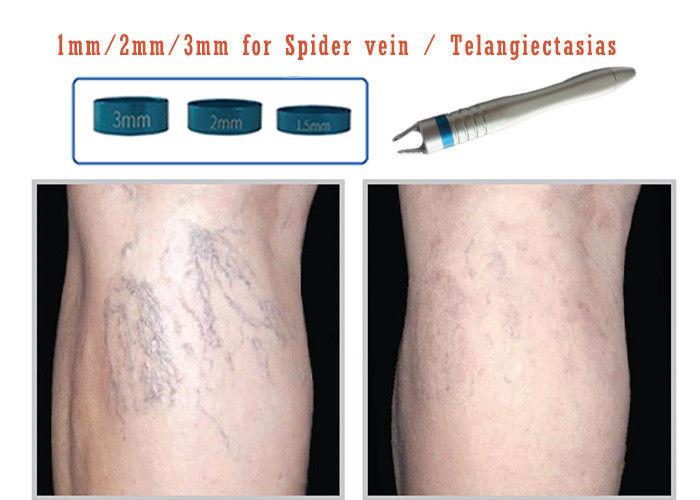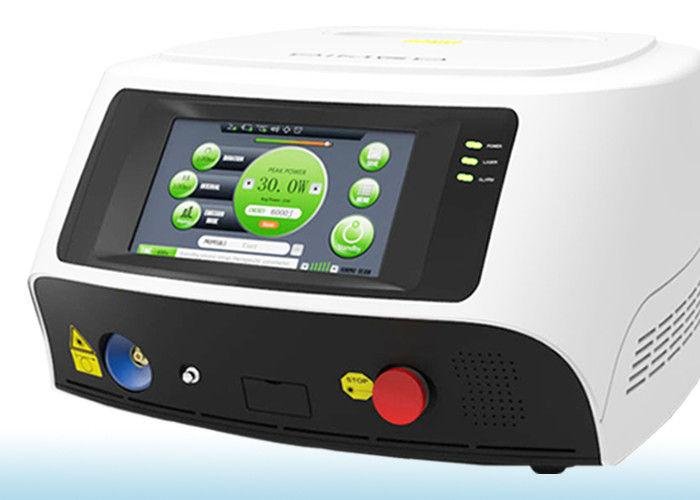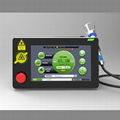| Model: | cherylas 940nm |
|---|---|
| Brand: | Dimed Laser |
| Origin: | Made In China |
| Category: | Industrial Supplies / Industrial Supplies Stocks |
| Label: | pigmentation removal , spidervein treatment , diode laser 940nm |
| Price: |
US $15000
/ pc
|
| Min. Order: | 1 pc |
Product Description
Laser Type: GaAlAs Diode Laser Wavelength: 940NM
Peak Power: 10w/ 15w / 20w / 30w Operation Mode: CW, Single Or Repeat Pulse
Pulse Duration: 10us-3s Repetition Rate: 0.2Hz- 50KHz
Pilot Beam: Red Diode Laser Of 650nm, Power<5mW Control Mode: True Color Touch Screen
Transmission System: Fibers Of 400um With SMA905 Connector Demensions: 305(W)*270(L)*145(H) Mm
Weight: 3Kg
The term telangiectasia originally described a superficial vessel of the skin visible to the human eye. On the leg, venous spiders, sunburst veins, dilated venules, ven ulecrasias, super ficial varicosities, and telangiec tatic vessels have all been designated as leg vein telangiectasia.11·12 On histopathologic examination, telangiectasias associated with varicose veins have been found in the reticular and pa pillary layers of the derm is and in the subcuta neous far mostly ru nning paral lel to the epidermis. Most of these vessels showed features of dilated cutaneous venules; less frequently, telangiectasias represented expanded capillaries or arterioles.B Accordingly, red and blue telangiectasias
have been distinguished, with a higher oxygen saturation in the red variam. A diameter of up to 1.0 mm has been described for spider veins type I according to the classification of varicose vessels b)' Weiss and Weiss. Type II vessels in this classi fication are 1.0-2.0 mm in diameter a n d are termed venulectasias. They may visibly protrude above the skin surface. The pa tients included in this study had vessels less than 1 mm in diameter, but they were not stratified ot henvise ac cording to vessel size a nd represe nr a cross section thro ugh the various types of leg vein telangiectasia encountered in daily practice.
Effective Treatment of Leg Vein Telangiectasia with a New 940 nm Diode Laser
Figure 5. (A) Telangiectatic vessels before treatment. (B) Complete clearing of vessels after three treatments in most areas. Initial te langiectatic matting is observed.
The anatomic features of leg veins derai led above define the requirements for a laser to effectively ta rget these vessels. Specifica ll y the following parameters are cri tical: penetration depth of l aser radiation into the skin and blood, pulse duration, and the proportion of laser energy absorbed by epidermal chromophores, mainly melanin. The 940 nm wavelength penetrates a bout 3 mm into the sk in and thus comfortably reaches most types of leg vein telangiectasias in the skin compart ments described above. The penetration of laser light imo blood is mainl)1 determined by the absorption of hemoglobin and by scarrering in the blood cells.The 940 nm wavelength rakes advanrage of a minor absorption peak of oxyhemoglobin at 910 nm. Red te langiectasias containing comparatively higher concen trations of this chromophore should therefore respond to this wavelength.
The effective penetration depth in blood for laser light at a wavelength of 940 nm according to rhediffusion theory is 260-360 11-m de pending on the o::--7gen concemration. Laser light penetrating this deep into rhe targeted vessel is capable of depositi ng enough energy within the lumen to cause clinically visible heat shrinking of the vessel wall. His tologic examination of a treated vessel s ests that the laser impact may induce structural cha nges in the targeted vessel. Th e 940 nm wavelengt h is ca pable of penetrating to the full depth of leg vein telangiectasias and allows treatment of vessels with diameters up ro1 mm. The deeper location of these vessels requires high fluences of at least 250-400 Jlcm1
Selectivity, that is, proportionally better absorption of the target than surrounding chromophores, is ach ieved because the absorption coefficient in blood is considerably higher than for the surrounding tissue. Penetration depths of 300 11-m in blood versus 3 mm in skin reflect this situation. The ava ilability of spot sizes near the vessel d iameter provide addi tional spatial selectiv ity to minimize damage to ad jacent tissue. Due to the low melanin absorption, epidermal inju ry is unl ikely. This is in contrast to other lasers such as dye, argon, KTP, a nd frequency-dou bled t d:YAG-lasers.
To effectively coagulate the target vessel wit hout damaging the surround ing tissue, the pulse d uration should be long enough to sl owly coagulate the vessel, but shoul d remain with in rhe the rma l relaxation time, which depends mainly on vessel diameter. For vessels with diameters of 200-800 11-m, such as leg vein te langiectasias, a thermal relaxarion ti me between 20 a nd 300 msec has been calcu1ated.Th e 940nm diode laser aUows one to vary the pulse duration between 10 and 100 msec. Based on the above calcul a tions, pulse durations of 40-70 msec were used with 700-msec intervals ro allow for precise placement ol the laser pulse.
With the above physical characteristics, the 940 nm diode laser f ulf ills the basic requirements for a laser ro effectively target leg veins. Absorption in melanin a nd in hemoglobin for various wavelengths used to treat leg vein telangiectasia is shown. In contrast to the 940 nm diode laser, other lasers such as KTP, frequency-dou bled Nd:YAG, dye, and argon featu re a high absorpt ion by both melanin a nd hemoglobin. In· tensive deposition of energy wit hin the epider mis with a high risk of epidermal injury and low penetration into the target vessels with in complete destruction.
We did not obse rve se rious si de effects even w hen usi ng high fl uences. Epider ma l damage was minima l and only transitory. Noneth eless, min ima l tela ngi ec tatic matti ng was observed in a few patients. The wide spread view is that because lasers em ploy d ifferent mech a nis ms, they are unlikely to produce this ad verse effect usually associated with scl erothera py. However, the over all side effect profile of the 940 nm diode laser still com pares quite fa vorably th other lasers.
| Payment Terms: | TT/West Union |
|---|---|
Member Information
| Wuhan Dimed Laser Technology Co., LTD. | |
|---|---|
| Country/Region: | Hu Bei - China |
| Business Nature: | Manufacturer |
| Phone: | 13597795703 |
| Contact: | Kim Dimed (sale) |
| Last Online: | 07 Nov, 2019 |
Related Products of this Company
-
45 Watts ENT Plastic Surgical Diode
US $8000
-
BERYLAS Veterinary Laser Equipment
US $8000
-
Class IV 980nm Podiatry Laser On Heel
US $15000
-
Different laser selection - compact size
US $8000
-
Diode Ent Laser Ear Nose Throat Ent
US $15000
-
Class 4 Deep Tissue Laser Back Treatment
US $8000
-
PERALAS Laser Therapy Machine
US $8000
-
Varicose Veins Endovenous Laser Therapy
US $8000
-
Dimed laser- BERYLAS offer noninvasive
US $8000
-
Ear Nose and Throat ENT Laser Surgery
US $8000












